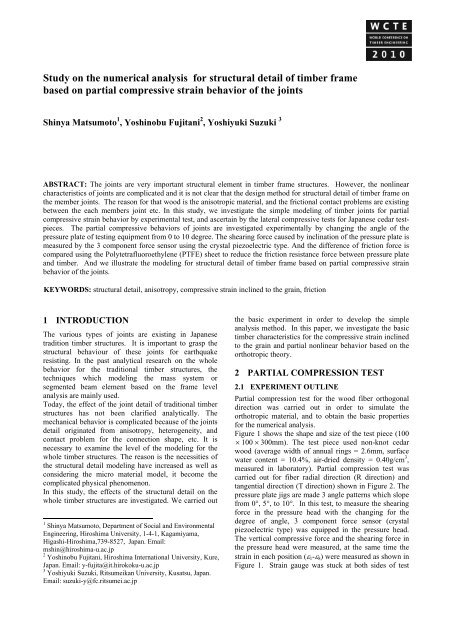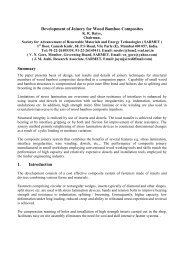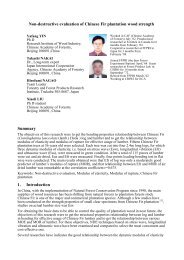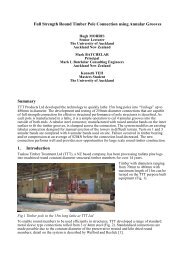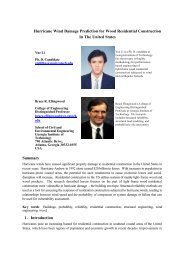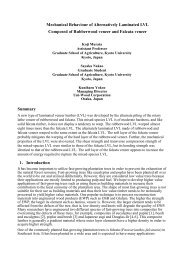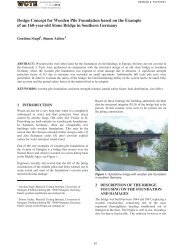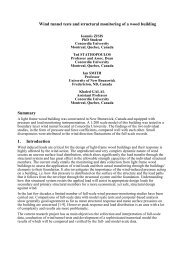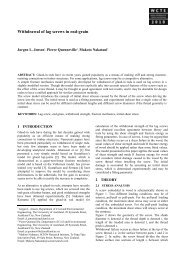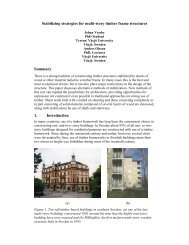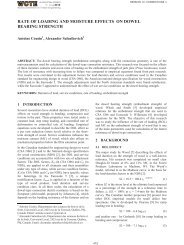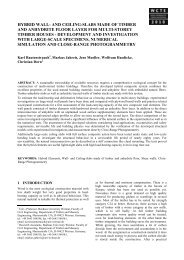Study on the numerical analysis for structural detail of timber frame ...
Study on the numerical analysis for structural detail of timber frame ...
Study on the numerical analysis for structural detail of timber frame ...
Create successful ePaper yourself
Turn your PDF publications into a flip-book with our unique Google optimized e-Paper software.
<str<strong>on</strong>g>Study</str<strong>on</strong>g> <strong>on</strong> <strong>the</strong> <strong>numerical</strong> <strong>analysis</strong> <strong>for</strong> <strong>structural</strong> <strong>detail</strong> <strong>of</strong> <strong>timber</strong> <strong>frame</strong><br />
based <strong>on</strong> partial compressive strain behavior <strong>of</strong> <strong>the</strong> joints<br />
Shinya Matsumoto 1 , Yoshinobu Fujitani 2 , Yoshiyuki Suzuki 3<br />
ABSTRACT: The joints are very important <strong>structural</strong> element in <strong>timber</strong> <strong>frame</strong> structures. However, <strong>the</strong> n<strong>on</strong>linear<br />
characteristics <strong>of</strong> joints are complicated and it is not clear that <strong>the</strong> design method <strong>for</strong> <strong>structural</strong> <strong>detail</strong> <strong>of</strong> <strong>timber</strong> <strong>frame</strong> <strong>on</strong><br />
<strong>the</strong> member joints. The reas<strong>on</strong> <strong>for</strong> that wood is <strong>the</strong> anisotropic material, and <strong>the</strong> fricti<strong>on</strong>al c<strong>on</strong>tact problems are existing<br />
between <strong>the</strong> each members joint etc. In this study, we investigate <strong>the</strong> simple modeling <strong>of</strong> <strong>timber</strong> joints <strong>for</strong> partial<br />
compressive strain behavior by experimental test, and ascertain by <strong>the</strong> lateral compressive tests <strong>for</strong> Japanese cedar testpieces.<br />
The partial compressive behaviors <strong>of</strong> joints are investigated experimentally by changing <strong>the</strong> angle <strong>of</strong> <strong>the</strong><br />
pressure plate <strong>of</strong> testing equipment from 0 to 10 degree. The shearing <strong>for</strong>ce caused by inclinati<strong>on</strong> <strong>of</strong> <strong>the</strong> pressure plate is<br />
measured by <strong>the</strong> 3 comp<strong>on</strong>ent <strong>for</strong>ce sensor using <strong>the</strong> crystal piezoelectric type. And <strong>the</strong> difference <strong>of</strong> fricti<strong>on</strong> <strong>for</strong>ce is<br />
compared using <strong>the</strong> Polytetrafluoroethylene (PTFE) sheet to reduce <strong>the</strong> fricti<strong>on</strong> resistance <strong>for</strong>ce between pressure plate<br />
and <strong>timber</strong>. And we illustrate <strong>the</strong> modeling <strong>for</strong> <strong>structural</strong> <strong>detail</strong> <strong>of</strong> <strong>timber</strong> <strong>frame</strong> based <strong>on</strong> partial compressive strain<br />
behavior <strong>of</strong> <strong>the</strong> joints.<br />
KEYWORDS: <strong>structural</strong> <strong>detail</strong>, anisotropy, compressive strain inclined to <strong>the</strong> grain, fricti<strong>on</strong><br />
1 INTRODUCTION 123<br />
The various types <strong>of</strong> joints are existing in Japanese<br />
traditi<strong>on</strong> <strong>timber</strong> structures. It is important to grasp <strong>the</strong><br />
<strong>structural</strong> behaviour <strong>of</strong> <strong>the</strong>se joints <strong>for</strong> earthquake<br />
resisting. In <strong>the</strong> past analytical research <strong>on</strong> <strong>the</strong> whole<br />
behavior <strong>for</strong> <strong>the</strong> traditi<strong>on</strong>al <strong>timber</strong> structures, <strong>the</strong><br />
techniques which modeling <strong>the</strong> mass system or<br />
segmented beam element based <strong>on</strong> <strong>the</strong> <strong>frame</strong> level<br />
<strong>analysis</strong> are mainly used.<br />
Today, <strong>the</strong> effect <strong>of</strong> <strong>the</strong> joint <strong>detail</strong> <strong>of</strong> traditi<strong>on</strong>al <strong>timber</strong><br />
structures has not been clarified analytically. The<br />
mechanical behavior is complicated because <strong>of</strong> <strong>the</strong> joints<br />
<strong>detail</strong> originated from anisotropy, heterogeneity, and<br />
c<strong>on</strong>tact problem <strong>for</strong> <strong>the</strong> c<strong>on</strong>necti<strong>on</strong> shape, etc. It is<br />
necessary to examine <strong>the</strong> level <strong>of</strong> <strong>the</strong> modeling <strong>for</strong> <strong>the</strong><br />
whole <strong>timber</strong> structures. The reas<strong>on</strong> is <strong>the</strong> necessities <strong>of</strong><br />
<strong>the</strong> <strong>structural</strong> <strong>detail</strong> modeling have increased as well as<br />
c<strong>on</strong>sidering <strong>the</strong> micro material model, it become <strong>the</strong><br />
complicated physical phenomen<strong>on</strong>.<br />
In this study, <strong>the</strong> effects <strong>of</strong> <strong>the</strong> <strong>structural</strong> <strong>detail</strong> <strong>on</strong> <strong>the</strong><br />
whole <strong>timber</strong> structures are investigated. We carried out<br />
1 Shinya Matsumoto, Department <strong>of</strong> Social and Envir<strong>on</strong>mental<br />
Engineering, Hiroshima University, 1-4-1, Kagamiyama,<br />
Higashi-Hiroshima,739-8527, Japan. Email:<br />
mshin@hiroshima-u.ac.jp<br />
2 Yoshinobu Fujitani, Hiroshima Internati<strong>on</strong>al University, Kure,<br />
Japan. Email: y-fujita@it.hirokoku-u.ac.jp<br />
3 Yoshiyuki Suzuki, Ritsumeikan University, Kusatsu, Japan.<br />
Email: suzuki-y@fc.ritsumei.ac.jp<br />
<strong>the</strong> basic experiment in order to develop <strong>the</strong> simple<br />
<strong>analysis</strong> method. In this paper, we investigate <strong>the</strong> basic<br />
<strong>timber</strong> characteristics <strong>for</strong> <strong>the</strong> compressive strain inclined<br />
to <strong>the</strong> grain and partial n<strong>on</strong>linear behavior based <strong>on</strong> <strong>the</strong><br />
orthotropic <strong>the</strong>ory.<br />
2 PARTIAL COMPRESSION TEST<br />
2.1 EXPERIMENT OUTLINE<br />
Partial compressi<strong>on</strong> test <strong>for</strong> <strong>the</strong> wood fiber orthog<strong>on</strong>al<br />
directi<strong>on</strong> was carried out in order to simulate <strong>the</strong><br />
orthotropic material, and to obtain <strong>the</strong> basic properties<br />
<strong>for</strong> <strong>the</strong> <strong>numerical</strong> <strong>analysis</strong>.<br />
Figure 1 shows <strong>the</strong> shape and size <strong>of</strong> <strong>the</strong> test piece (100<br />
100 300mm). The test piece used n<strong>on</strong>-knot cedar<br />
wood (average width <strong>of</strong> annual rings = 2.6mm, surface<br />
water c<strong>on</strong>tent = 10.4%, air-dried density = 0.40g/cm 3 ,<br />
measured in laboratory). Partial compressi<strong>on</strong> test was<br />
carried out <strong>for</strong> fiber radial directi<strong>on</strong> (R directi<strong>on</strong>) and<br />
tangential directi<strong>on</strong> (T directi<strong>on</strong>) shown in Figure 2. The<br />
pressure plate jigs are made 3 angle patterns which slope<br />
from 0°, 5°, to 10°. In this test, to measure <strong>the</strong> shearing<br />
<strong>for</strong>ce in <strong>the</strong> pressure head with <strong>the</strong> changing <strong>for</strong> <strong>the</strong><br />
degree <strong>of</strong> angle, 3 comp<strong>on</strong>ent <strong>for</strong>ce sensor (crystal<br />
piezoelectric type) was equipped in <strong>the</strong> pressure head.<br />
The vertical compressive <strong>for</strong>ce and <strong>the</strong> shearing <strong>for</strong>ce in<br />
<strong>the</strong> pressure head were measured, at <strong>the</strong> same time <strong>the</strong><br />
strain in each positi<strong>on</strong> (1-8) were measured as shown in<br />
Figure 1. Strain gauge was stuck at both sides <strong>of</strong> test
piece, and <strong>the</strong> mean value was obtained <strong>on</strong> <strong>the</strong> each<br />
point 1-6.<br />
In this test, <strong>the</strong> partial compressi<strong>on</strong> test was carried out<br />
by inserting <strong>the</strong> Polytetrafluoroethylene (PTFE) sheet<br />
between pressure plate and surface <strong>of</strong> test piece in order<br />
to reduce <strong>the</strong> effect <strong>of</strong> <strong>the</strong> fricti<strong>on</strong>. The list <strong>of</strong> <strong>the</strong> test<br />
specimen is shown in Table 1.<br />
100<br />
7<br />
15<br />
Figure 1: Partial compressi<strong>on</strong> test<br />
R<br />
Figure 2: Load directi<strong>on</strong><br />
Table 1: List <strong>of</strong> <strong>the</strong> test specimen<br />
No. Symbol<br />
Load<br />
directi<strong>on</strong><br />
Angle<br />
(deg.)<br />
1 R00T<br />
0<br />
2 R05T Radial 5<br />
3 R10T 10<br />
4 T00T<br />
0<br />
5 T05T Tangential 5<br />
6 T10T 10<br />
P<br />
Q<br />
300<br />
<br />
1 2 3<br />
4 5 6<br />
45 45 15<br />
2.2 RESULT OF THE EXPERIMENT<br />
The vertical load - vertical displacement relati<strong>on</strong> <strong>for</strong> <strong>the</strong><br />
R directi<strong>on</strong> loading test is shown in Figure 3. Also, <strong>the</strong><br />
vertical load - vertical displacement relati<strong>on</strong> <strong>for</strong> <strong>the</strong> T<br />
directi<strong>on</strong> loading test is shown in Figure 4. From <strong>the</strong>se<br />
figures, it is proven that <strong>the</strong> initial rigidity <strong>for</strong> load-<br />
8<br />
T<br />
15<br />
35<br />
50<br />
(Units : mm)<br />
displacement relati<strong>on</strong> becomes low with <strong>the</strong> increase <strong>of</strong><br />
angle <strong>of</strong> <strong>the</strong> pressure plate changing to 0°, 5°, 10°.<br />
Load P (kN)<br />
70<br />
60<br />
50<br />
40<br />
30<br />
20<br />
10<br />
0<br />
R00T<br />
R05T<br />
R10T<br />
0 5 10 15<br />
Displacement (mm)<br />
Figure 3: Vertical load - vertical displacement relati<strong>on</strong><br />
(R00T, R05T, R10T)<br />
Load P (kN)<br />
80<br />
70<br />
60<br />
50<br />
40<br />
30<br />
20<br />
10<br />
0<br />
T05T<br />
T00T<br />
0 5 10 15<br />
Displacement (mm)<br />
T10T<br />
Figure 4: Vertical load - vertical displacement relati<strong>on</strong><br />
(T00T, T05T, T10T)<br />
Figure 5 shows <strong>the</strong> horiz<strong>on</strong>tal load - vertical<br />
displacement relati<strong>on</strong> <strong>for</strong> R directi<strong>on</strong> test measured by<br />
<strong>the</strong> 3 comp<strong>on</strong>ent <strong>for</strong>ce sensor. From <strong>the</strong> Figure, it is<br />
proven that <strong>the</strong> shearing <strong>for</strong>ce in <strong>the</strong> pressure head tends<br />
to decrease when <strong>the</strong> pressure plate angle grows<br />
comparis<strong>on</strong> 5° with 10°.<br />
Shearing <strong>for</strong>ce Q (kN)<br />
3<br />
2.5<br />
2<br />
1.5<br />
1<br />
0.5<br />
0<br />
R05T<br />
R10T<br />
0 5 10 15<br />
Displacement (mm)<br />
Figure 5: Horiz<strong>on</strong>tal load - vertical displacement relati<strong>on</strong><br />
(R05T R10T)
Load-compressive strain relati<strong>on</strong> <strong>of</strong> test (R00T) is shown<br />
in <strong>the</strong> Figure 6, Figure 7.<br />
Load (kN)<br />
Figure 6: Load-compressive strain (1, 2, 3) relati<strong>on</strong><br />
(R00T)<br />
Load (kN)<br />
Figure 7: Load-compressive strain (4,5, 6) relati<strong>on</strong><br />
(R00T)<br />
Load (kN)<br />
Figure 8: Load-compressive strain (1, 2, 3) relati<strong>on</strong><br />
(R10T)<br />
Load (kN)<br />
40<br />
35<br />
30<br />
25<br />
20<br />
15<br />
10<br />
5<br />
0<br />
40<br />
35<br />
30<br />
25<br />
20<br />
15<br />
10<br />
5<br />
0<br />
40<br />
35<br />
30<br />
25<br />
20<br />
15<br />
10<br />
5<br />
0<br />
1<br />
0 1000 2000 3000<br />
Compressive strain (μ)<br />
2<br />
3<br />
0 1000 2000 3000<br />
40<br />
35<br />
30<br />
25<br />
20<br />
15<br />
10<br />
5<br />
0<br />
6<br />
4<br />
Compressive strain (μ)<br />
5<br />
-500 500 1500 2500<br />
6<br />
Compressive strain (μ)<br />
4<br />
3<br />
2<br />
5<br />
1<br />
0 1000 2000 3000<br />
Compressive strain (μ)<br />
Figure 9: Load-compressive strain (4, 5, 6) relati<strong>on</strong><br />
(R10T)<br />
Load-compressive strain relati<strong>on</strong> <strong>of</strong> test (R10T) is shown<br />
in <strong>the</strong> Figure 8, Figure 9.<br />
Load-tensile strain relati<strong>on</strong> <strong>of</strong> test (R00T) and (R10T) is<br />
shown in <strong>the</strong> Figure 10, Figure 11.<br />
Load (kN)<br />
Figure 10: Load-tensile strain (7, 8) relati<strong>on</strong> (R00T).<br />
Load (kN)<br />
40<br />
35<br />
30<br />
25<br />
20<br />
15<br />
10<br />
5<br />
0<br />
-500 500 1500 2500<br />
40<br />
35<br />
30<br />
25<br />
20<br />
15<br />
10<br />
5<br />
0<br />
7<br />
8<br />
Tensile strain (μ)<br />
8<br />
7<br />
-500 500 1500 2500<br />
Tensile strain (μ)<br />
Figure 11: Load-tensile strain (7, 8) relati<strong>on</strong> (R10T).<br />
The strain <strong>of</strong> each part <strong>for</strong> change <strong>of</strong> <strong>the</strong> sinkage angle<br />
was shown from <strong>the</strong>se figures. For <strong>the</strong> reference, <strong>the</strong><br />
compressive strain inclined to <strong>the</strong> grain <strong>for</strong> R directi<strong>on</strong><br />
test are shown in Figure 12-Figure 14
Figure 12: Compressive strain inclined to <strong>the</strong> grain<br />
(R00T)<br />
Figure 13: Compressive strain inclined to <strong>the</strong> grain<br />
(R05T)<br />
Figure 14: Compressive strain inclined to <strong>the</strong> grain<br />
(R10T)<br />
3 CROSS-SHAPED FRAME TEST<br />
3.1 EXPERIMENT OUTLINE<br />
In this study, cross-shaped <strong>frame</strong> is made using n<strong>on</strong>-knot<br />
cedar wood with column cross secti<strong>on</strong> 100100mm and<br />
nuki-beam cross secti<strong>on</strong> 40100mm. The column upper<br />
and bottom ends are restricted by <strong>the</strong> pin support as<br />
shown in Figure 15.<br />
Intertru<br />
ss<br />
振れ止め<br />
Load P 1<br />
Disp. 1 Disp. 2 200 200<br />
DG3<br />
DG5<br />
+<br />
-<br />
DG1<br />
50 50<br />
DG7<br />
DG4<br />
100<br />
300<br />
DG6<br />
100<br />
DG8<br />
250 250<br />
500<br />
250 250<br />
300<br />
160<br />
DG10 DG11<br />
DG12 DG13<br />
160<br />
DG9<br />
50<br />
50<br />
200<br />
振れ止め<br />
DG2<br />
Intertru<br />
ss<br />
Load P 2<br />
-<br />
+<br />
Figure 15: Test specimen dimensi<strong>on</strong> and displacement<br />
measurement positi<strong>on</strong><br />
The loading test was carried out by using two electr<strong>on</strong>ic<br />
c<strong>on</strong>trol actuators to applied antisymmetric vertical<br />
displacement <strong>for</strong> <strong>the</strong> nuki beam ends.<br />
Cotter pin<br />
40<br />
60<br />
304030<br />
140<br />
140<br />
2060<br />
20<br />
込栓(15×15) 304030<br />
20<br />
60<br />
40<br />
2060 20<br />
20<br />
くさび Wedge<br />
20<br />
Wedge くさび<br />
Wedge<br />
くさび<br />
Model A<br />
(Complete nuki joint)<br />
Model B<br />
(Link nuki joint)<br />
Model C<br />
(Link nuki joint with cotter pin)<br />
Figure 16: The <strong>detail</strong>s <strong>of</strong> <strong>the</strong> each test specimen juncture<br />
The <strong>frame</strong> models were made 3 types which different <strong>of</strong><br />
<strong>the</strong> joint <strong>detail</strong> as shown in Figure 16. The model A is<br />
complete c<strong>on</strong>tinuous beam joint, and <strong>the</strong> horiz<strong>on</strong>tal beam<br />
member is <strong>on</strong>e part element (it is called complete nuki<br />
joint). Model B is <strong>the</strong> joint processing <strong>the</strong> right and left<br />
members like key-shape, and c<strong>on</strong>sist <strong>of</strong> disc<strong>on</strong>tinues<br />
beam (it is called link nuki joint). Model C is stricken <strong>the</strong><br />
cotter pin to <strong>the</strong> linke nuki joint, and <strong>the</strong> disc<strong>on</strong>tinuous<br />
beam is fixed in <strong>the</strong> c<strong>on</strong>necti<strong>on</strong> inside (it is called link<br />
nuki joint with cotter pin). These joints have also fixed<br />
by driving two wedges (zelkova material) <strong>on</strong> <strong>the</strong> upper<br />
clearance between column and beam. The <strong>detail</strong>s <strong>of</strong> each<br />
part are shown in Figure 16.<br />
The whole view <strong>of</strong> Model A is shown in Figure 17. The<br />
Model A has been bound <strong>the</strong> 1/3 span from <strong>the</strong> edge <strong>of</strong><br />
<strong>the</strong> horiz<strong>on</strong>tal bracing <strong>for</strong> out-<strong>of</strong>-plane de<strong>for</strong>mati<strong>on</strong> by<br />
steel pipes (intertruss braceing) which covered PTFE<br />
sheet to reduce <strong>the</strong> fricti<strong>on</strong>.
Figure 17: Test specimen Model A<br />
The loading program is shown in Figure 18, and <strong>the</strong><br />
target displacement each 3 cycles (<strong>for</strong> de<strong>for</strong>mati<strong>on</strong><br />
angle: 1/50rad, 1/20rad, 1/15rad, 1/450rad, <br />
1/300rad, 1/200rad, 1/150rad, 1/100rad, <br />
1/75rad ) is antisymmetric displacement c<strong>on</strong>trol which<br />
repeatedly increased. Throughout this paper, <strong>the</strong> load<br />
and displacement <strong>of</strong> left side is described by symbol P1<br />
and 1, <strong>the</strong> load and displacement <strong>of</strong> right side is<br />
described by symbol P2 and 2. The sign was defined <strong>for</strong><br />
<strong>the</strong> directi<strong>on</strong> <strong>of</strong> <strong>the</strong> arrow respectively shown in Figure<br />
15.<br />
Target displacement(mm)<br />
80<br />
60<br />
40<br />
20<br />
0<br />
-20<br />
-40<br />
-60<br />
-80<br />
1/450 1/300 1/200 1/150 1/100 1/75 1/50 1/20 1/15<br />
0 6 12 18 24 30<br />
Cycles<br />
36 42 48 54 60<br />
Figure 18: The loading program<br />
3.2 RESULT OF THE EXPERIMENT<br />
Figure 19 shows <strong>the</strong> load P1- displacement 1 relati<strong>on</strong><br />
and Figure 20 shows <strong>the</strong> load P2- displacement 2<br />
relati<strong>on</strong> <strong>for</strong> Model A. The sign <strong>of</strong> <strong>the</strong> load and<br />
displacement are defined <strong>the</strong> directi<strong>on</strong> <strong>of</strong> <strong>the</strong> arrow as<br />
shown in Figure 15. From <strong>the</strong>se figures, it is proven that<br />
<strong>the</strong> mechanical characteristics under <strong>the</strong> loading regi<strong>on</strong><br />
<strong>for</strong> displacement 15mm (<strong>for</strong> de<strong>for</strong>mati<strong>on</strong> angle: 1/50rad)<br />
in Model A is approximately symmetric behavior.<br />
Figure 21 shows <strong>the</strong> load P1- displacement 1 relati<strong>on</strong><br />
and Figure 22 shows <strong>the</strong> load P2- displacement 2<br />
relati<strong>on</strong> <strong>for</strong> Model B. From <strong>the</strong>se figures, It is proven<br />
that <strong>the</strong> mechanical characteristics under <strong>the</strong> loading<br />
regi<strong>on</strong> <strong>for</strong> displacement 15mm (<strong>for</strong> de<strong>for</strong>mati<strong>on</strong> angle:<br />
1/50rad) in Model B is unsymmetrical behaviour<br />
different from Model A. Also, it tends to show <strong>the</strong><br />
linearity de<strong>for</strong>mati<strong>on</strong> and low rigidity <strong>for</strong> <strong>the</strong> positive<br />
load and de<strong>for</strong>mati<strong>on</strong> in <strong>the</strong> directi<strong>on</strong> <strong>for</strong> <strong>the</strong> first<br />
quadrant <strong>of</strong> <strong>the</strong> graph. But, it tends to show <strong>the</strong> large slip<br />
hysteresis curve <strong>for</strong> negative load and de<strong>for</strong>mati<strong>on</strong> in <strong>the</strong><br />
directi<strong>on</strong> <strong>for</strong> <strong>the</strong> third quadrant <strong>of</strong> <strong>the</strong> graph. These are<br />
supposed <strong>the</strong> effect <strong>of</strong> <strong>the</strong> disc<strong>on</strong>tinuous beam<br />
c<strong>on</strong>necti<strong>on</strong> shape and driving two wedges in <strong>the</strong> Model<br />
B.<br />
Load P1(kN)<br />
0.8<br />
0.6<br />
0.4<br />
0.2<br />
0<br />
-50 -30 -10 10 30 50<br />
‐0.2<br />
‐0.4<br />
‐0.6<br />
‐0.8<br />
Displacement (mm)<br />
Figure 19: The load P1- displacement 1 relati<strong>on</strong> (Model<br />
A).<br />
Load P2(kN)<br />
0.8<br />
0.6<br />
0.4<br />
0.2<br />
0<br />
-50 -30 -10 10 30 50<br />
‐0.2<br />
‐0.4<br />
‐0.6<br />
‐0.8<br />
Displacement (mm)<br />
Figure 20: The load P2- displacement 2 relati<strong>on</strong> (Model<br />
A).<br />
Load P1(kN)<br />
0.8<br />
0.6<br />
0.4<br />
0.2<br />
0<br />
-50 -30 -10 10 30 50<br />
‐0.2<br />
‐0.4<br />
‐0.6<br />
‐0.8<br />
Displacement (mm)<br />
Figure 21: The load P1- displacement 1 relati<strong>on</strong> (Model<br />
B).<br />
Load P2(kN)<br />
0.8<br />
0.6<br />
0.4<br />
0.2<br />
0<br />
-50 -30 -10 10 30 50<br />
‐0.2<br />
‐0.4<br />
‐0.6<br />
‐0.8<br />
Displacement (mm)<br />
Figure 22: The load P2- displacement 2 relati<strong>on</strong> (Model<br />
B).<br />
Figure 23 shows <strong>the</strong> load P1- displacement 1 relati<strong>on</strong><br />
and Figure 24 shows <strong>the</strong> load P2- displacement 2<br />
relati<strong>on</strong> <strong>for</strong> Model C. From <strong>the</strong>se figures, more
symmetrical mechanical characteristic is shown in<br />
Model C compared with Model B. It is c<strong>on</strong>sidered that<br />
Model C is stricken <strong>the</strong> cotter pin to <strong>the</strong> disc<strong>on</strong>tinuous<br />
beam.<br />
Load P1(kN)<br />
Figure 23: The load P1- displacement 1 relati<strong>on</strong> (Model<br />
C).<br />
Load P2(kN)<br />
-50 -30 -10 10 30 50<br />
‐0.2<br />
‐0.4<br />
‐0.6<br />
‐0.8<br />
Displacement (mm)<br />
Figure 24: The load P2- displacement 2 relati<strong>on</strong> (Model<br />
C).<br />
The final state <strong>of</strong> each tests are shown in Figure 25-<br />
Figure 27.<br />
Figure 25: The final state <strong>of</strong> Model A<br />
Figure 26: The final state <strong>of</strong> Model B<br />
0.8<br />
0.6<br />
0.4<br />
0.2<br />
0<br />
0.8<br />
0.6<br />
0.4<br />
0.2<br />
0<br />
-50 -30 -10 10 30 50<br />
‐0.2<br />
‐0.4<br />
‐0.6<br />
‐0.8<br />
Displacement (mm)<br />
Figure 27: The final state <strong>of</strong> Model C<br />
4 CONCLUSIONS<br />
In this paper, <strong>the</strong> basic experimental tests <strong>for</strong> <strong>timber</strong><br />
were carried out to investigate <strong>the</strong> effects <strong>of</strong> <strong>the</strong><br />
<strong>structural</strong> <strong>detail</strong>. And we investigated <strong>the</strong> basic <strong>timber</strong><br />
characteristics <strong>for</strong> <strong>the</strong> compressive strain inclined to <strong>the</strong><br />
grain and partial n<strong>on</strong>linear behaviour. These<br />
experimental results are important data <strong>for</strong> <strong>the</strong> <strong>numerical</strong><br />
<strong>analysis</strong> based <strong>on</strong> <strong>the</strong> orthotropism <strong>the</strong>ory.<br />
ACKNOWLEDGEMENT<br />
This work was supported by JSPS KAKENHI 19106010.<br />
REFERENCES<br />
[1] H J Larsen and J L Jensen: Influence <strong>of</strong> semirigidity<br />
<strong>of</strong> joints <strong>on</strong> <strong>the</strong> behaviour <strong>of</strong> <strong>timber</strong><br />
structures. Prog. Struct. Engng Mater., 2, 267-277,<br />
2000.<br />
[2] B. Kasal1, S. Pospisil, I. Jirovsky, A. Heiduschke,<br />
M. Drdacky and P. Haller: Seismic per<strong>for</strong>mance <strong>of</strong><br />
laminated <strong>timber</strong> <strong>frame</strong>s with fiber-rein<strong>for</strong>ced joints,<br />
Earthquake Engng Struct. Dyn., 33, pp.633-646,<br />
2004.<br />
[3] A. M. Tarabia and R. Y. Itani: Static And Dynamic<br />
Modeling <strong>of</strong> Light-Frame Wood Buildings,<br />
Compurm & Strucures, Vol. 63, No. 2, pp. 319-<br />
334, 1997.<br />
[4] Xiaobin S<strong>on</strong>g, Frank Lam: Laterally braced wood<br />
beam-columns subjected to biaxial eccentric loading,<br />
Compurm & Strucures, 87, 1058–1066, 2009.<br />
[5] H. R. Milner, H. H. Tan, Modelling de<strong>for</strong>mati<strong>on</strong> in<br />
nailed, thin-webbed <strong>timber</strong> box beams, Compurm &<br />
Strucures, 79, 2541–2546, 2001.<br />
[6] Wen-Shao Chang, J<strong>on</strong>athan Shanks, Akihisa<br />
Kitamori and Kohei Komatsu: The <strong>structural</strong><br />
behaviour <strong>of</strong> <strong>timber</strong> joints subjected to bi-axial<br />
bending, Earthquake Engng Struct. Dyn., 38, 739–<br />
757, 2009.


